
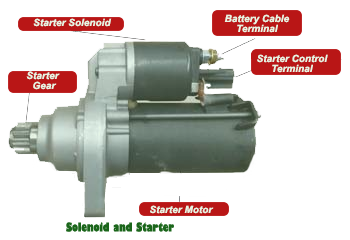 Starting an internal combustion engine requires support. Support which comes from the inertia car starter.
Starting an internal combustion engine requires support. Support which comes from the inertia car starter.
The starter calls on two complementary components to complete the ignition process.
The Bendix drive engages the pinion gear on the engine, disengaging automatically after the engine starts.
The solenoid is the generic term for a device that converts electrical energy to mechanical energy by creating a magnetic field from an electric current to create linear motion.
 The principal function of the starter solenoid, a simple electromagnet, is to control the ignition process through activating a unit known as the contactor that, as its title suggests, connects the vehicle battery to the starter motor.
The principal function of the starter solenoid, a simple electromagnet, is to control the ignition process through activating a unit known as the contactor that, as its title suggests, connects the vehicle battery to the starter motor.
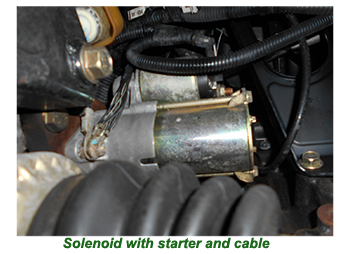 Solenoid describes an electromagnet that converts electrical energy to mechanical energy by creating a magnetic field from an electric current and uses the magnetic field to create linear motion.
Solenoid describes an electromagnet that converts electrical energy to mechanical energy by creating a magnetic field from an electric current and uses the magnetic field to create linear motion.
Car manufacturers in the US began to fit the starter solenoid from the mid-Thirties to move the starter pinion into engagement with the engine's ring gear.
The starter solenoid gradually evolved from this point onwards, with post-war vehicles fitting them as standard in the US as well as the UK and Western Europe.
The earlier starter solenoids were sealed units, a design still used in automatics today. From the Sixties and onwards, certain upmarket were fitted with remote starters featuring a button on top which manually closed the primary contacts.
![]()
Commonly found on vehicles from the mid-seventies onward, the pre-engaged starter has become the norm. The solenoid is mounted piggyback on the motor and doubles as current switch and pinion launcher in this format.
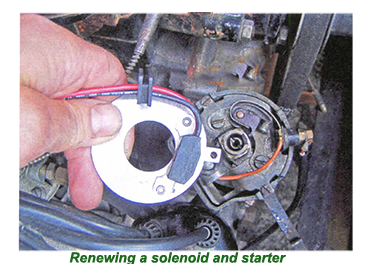 The motor is usually of the series variety, which is to say that both the field coils and rotating arm armature coils are supplied one after the other from a common source.
The motor is usually of the series variety, which is to say that both the field coils and rotating arm armature coils are supplied one after the other from a common source.
This arrangement offers greater starting torque over the alternative 'shunt motor' in which the field and armature are supplied in parallel.
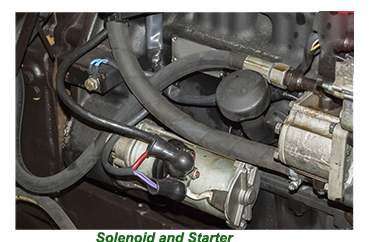 The starter motor is very reliable in operation, though the carbon brushes are prone to wearing and need regular replacement.
The starter motor is very reliable in operation, though the carbon brushes are prone to wearing and need regular replacement.
Likewise, the commutator can become clogged with dust from the brushes, so a clean will never go amiss.
Vehicles fitted with pre-engaged starters use the magnetic plunger of the solenoid to actively push and pull the starter pinion in and out of mesh with the flywheel.
This has the advantage of placing the gear in contact with the ring gear before the motor turns, thus reducing wear and the risk of sticking.
The solenoid is an exceptionally reliable piece of equipment, meaning that it should require little or no service by the owner.In the event of a breakdown, replacement solenoids are inexpensive and easily replaced.
![]()
Those lacking experience should consult with their local auto-electrician but should know that there is little need to replace the starter motor when replacing the solenoid starter.
Most of the earlier inertia starter motors came fitted with the starting pinion mounted on its front end. The pinion is drawn toward the motor body along a helical spline and into mesh with the ring gear when the motor is activated.
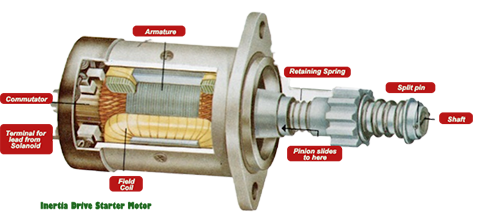 When the engine fires, it rotates the pinion faster than the motor; as this happens, the same spline will tend to pull the pinion out of the mesh.
When the engine fires, it rotates the pinion faster than the motor; as this happens, the same spline will tend to pull the pinion out of the mesh.
 The disadvantage of the inertia starter is that if the engine 'coughs' but fails to start, the pinion will not be in the mesh position to allow immediate ignition.
The disadvantage of the inertia starter is that if the engine 'coughs' but fails to start, the pinion will not be in the mesh position to allow immediate ignition.
Instead, the engine, although it will "cough and splutter" just a little, will inevitably turn over.


